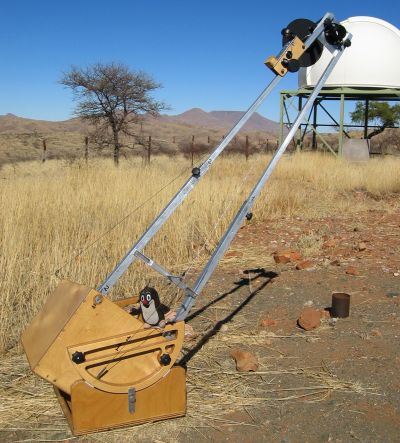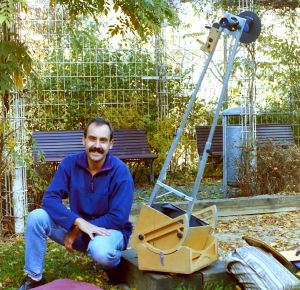| Home | Material | My Telescopes | Mirror Making | Deep Sky | ext. Links |
| 32" Mirror | 24" Kyklopas | 17,5" Aristarchos | 14" Mirror | 10" Archimedes | 10" Travel Dobson | 24 cm Quints | 17 cm Twins | 6" Traveldobson |
| Deutsch (de)![]()
| Home | Material | My Telescopes | Mirror Making | Deep Sky | ext. Links |
| 32" Mirror | 24" Kyklopas | 17,5" Aristarchos | 14" Mirror | 10" Archimedes | 10" Travel Dobson | 24 cm Quints | 17 cm Twins | 6" Traveldobson |
Travel Archimedes 10" f/5.4
 Image by Frank Richardsen, Namibia 2005 |
10
inch Dobsonian 10 Kilogram Hand Luggage
|
 click on the images to expand them |
What about your motorized 14-Zoll Schmidt- Cassegrain in the living room, if you have to live on vacation in the Namib dessert in Namibia with 8 x 40 binoculars? I agree, space walking through the southern milky way with binoculars is a delicacy for the eyes of a stargazer. This can work for another 2 nights, since this is the average incubation time for Aperture Fever, this insidious virus, which attacks nearly every amateur astronomer, as soon as he gets exposed to stardust and asks for "brighter, bigger, more" The philosophy of visual astronomy yields to the following question: How to get as much an aperture under as dark a sky as possible?
I had made in the beginning of the nineties a 10" f/5.4 mirror and mounted it in a 30 kg (66 lb) heavy Dobsonian with the name Archimedes, which I and my Berlin astro- friends had a lot of fun with. The imagination, to capture with this nice mirror the Eta- Carina nebula and the Magellanic Clouds onto the retina caused sleepless nights. How I get 10 inches onto the airplane? Will 8 trusses fit into the suitcase? Why I need a secondary cage at all? Can't I nail the eyepiece with 2 bars directly onto the glass? The 2 bar idea I had realized with my 6" Travel Dobson at 6 kg (13 lb) before, but here the mirror itself weighted 5 kg (11 lb) already, so I had to "hunger out" every single gram from the mechanical structure. Of course, any compromise regarding optical and mechanical performance was strictly forbidden.. After some weeks of intensive work the new "Travel Archimedes" was born: 10 inches at 10 kg (22lb) and compact enough to fit into nearly every airplane hand luggage compartment (34 x 31 x 30 cm). You pass with your wooden "beauty case" sovereign through the security check and are sure, that you didn't forget anything. In the mirror box there are besides the primary mirror, which lies secure in its cell separated by the mirror cover all parts needed: Altitude bearings, secondary-focuser assembly, reflex finder, all bolts and tightening strings, eyepieces, red LED light torch, observing book and warm socks. The 2 bars can be folded and fit into every suitcase or backpack. Set up takes 8 minutes including collimation, without any tools of course. For all wood parts I use Baltic Birch plywood. Beech plywood is a bit heavier and very strong as well, but is more difficult to find, at least in Germany. Look after as many layers as possible for a given thickness. In Germany you can find a so called "Gabun plywood", which is more lightweight, but not as stable as Birch. Use this stuff where weight is a bigger issue than stability. For all removable screw connections I use threaded inserts (T-nuts), that are knocked into the wood and additionally secured with epoxy glue. The details: The mirror box is screwed and glued out of 6.5 mm (0.26") plywood. The bottom panel and the reinforcements in the corners provide the needed stability. Only the side panel, where the bars are attached to, is made out of 9 mm (0.35") material. Everything is so strong, it survives even harsh treatment. The mirror support is a modified 9-point flotation cell. The mirror rests on the corners of 3 small triangles whose centers pivot on the 3 collimation bolts. Two rectangular hollow bars of 15 x 15 x 2 mm (0.6" x 0.6" x 0.08") transfer the weight of the mirror to the box. Wooden stoppers provide the radial support and leave a small gap, to allow for free floating mirror. Due to this low profile cell and the cut off corner at the front side the mirror floats barely 20 mm (0.8") above the bottom of the mirror box! At the eyepiece end it is essential, to save weight as much as you can. Here at the long lever arm every single gram counts, to bring the mass of equilibrium down! So the usual secondary cage diminished to an "focuser - secondary holder head" which is fixed via 2 clamp knobs at the bars. A simple but ultra-light 1¼" helical focuser from Lumicon is sufficient to bring to focus all my favorite eyepieces. The secondary with its adjustable holder hangs on two V- oriented steel sheets. However, I never need to re-collimate the secondary. Directly behind the the diagonal holder (so in the light path!) there is one of the most important components: The secondary baffle, made out of pebbled sheet aluminum. It prevents stray light from reaching the eyepiece very effectively and can be kept much smaller compared to baffles, that are placed opposite the focuser outside the light path. On top of this I use ring baffles made of empty filter sleeves with threads to both sides and plastic film cans. They are threaded directly onto the eyepieces and accept form the other side additional UHC or OIII filters. Every eyepiece has it's own baffle sized for it's specific field of view. Imagine, that you need to prevent the stay light only from falling into the eyepiece. As long as you achieve this, you won the game. Instead, other light straying around does not need to really bother you too much. The "tube" is reduced into two divisible aluminum rectangular hollow bars. The upper profile of 15 x 15 x 2 mm (0.6" x 0.6" x 0.08") is inserted into the lower one of 20 x 20 x 2 mm (0.8" x 0.8" x 0.08") and tightened with a single bolt via defined push and pull contact points. That is rock solid with no play. The lower bars are inserted into sockets at the bottom of the mirror box and are tightened with a single clamp knob each as well. The bars are in observing position in total 1,31 m long, inserted for transport 0,71 m. Due to the triangular orientation of the truss bars the structure is stiff along the plane of this triangle. Perpendicular to this plane it is statically unstable and is thus tightened with steel bowden cables like being used for bicycle shift mechanisms. At the mirror box the strings are inserted via separators to keep them outside the light path. All 3 strings have different lengths to better cancel out vibrations. At the telescope meetings it was called "Guitar Dobson". The sound is not really fine, but flex and vibrations were diminished by factor 4 at least! The altitude bearings are made as big as possible, but still small enough, to fit into the mirror box for transport. The teflon slides on textured kitchen counter top laminate similar to Formica. With my 180-280 g heavy 1.25" eyepices, that I use for this scope it is perfectly balanced. A brake is activated during the eyepiece change. The rockerbox is made as sandwich conbstruction to safe weight (see sandwich side und sandwich bottom). The azimuth bearing is covered with pebbled "gold coated" aluminum sheet, like used to cover window benches. The movements work "buttery smooth" at mainly equal forces in both axes.
Conclusion: As a single disadvantage of this minimalism design the use of 2" eyepieces is not possible, but with my 24 mm wide field I get one whole degree field of view. Furthermore the balancing point of the instrument is a bare 270 mm (10.6") above the ground, which is not very comfortable, when viewing near the horizon. Therefore I have always a foam camping mattress with me, that I need at vacation anyhow, on which I can lie, knee or sit, according to the eyepiece height. Ok, the secondary baffle is inside the light path and introduces an additional diffraction spike, which diminishes contrast, at least in theory. On the other hand, due to the small focus distance from the axis I could choose a 39 mm (1.52") diagonal, which provides 15% linear obstruction only. Having Jupiter in the 4.8 mm Nagler at good seeing you forget about diffraction theory anyhow. The mirror quality is what counts most. The structure is stable and has a very small wind resistance area. Imagine yourself being at a lonely beach in Greece, on the Teide in Tenerife or in the Namib desert enjoying the southern milky way. Inspired to build a travel Dobson yourself? |
Home | Imprint | Privacy Policy | about |